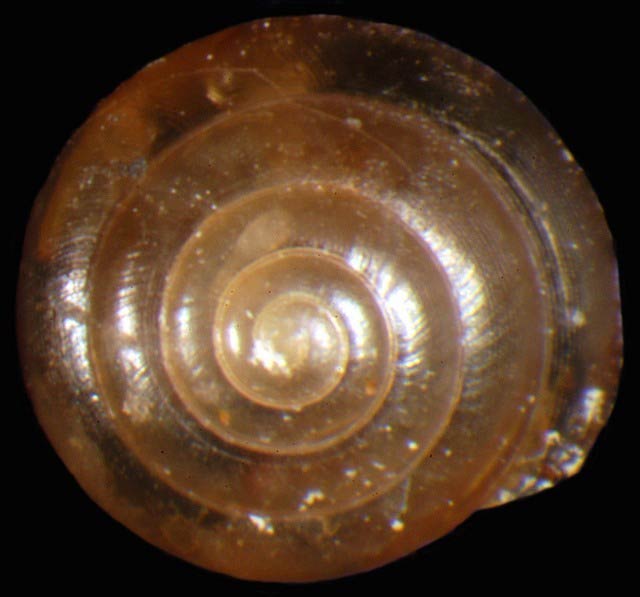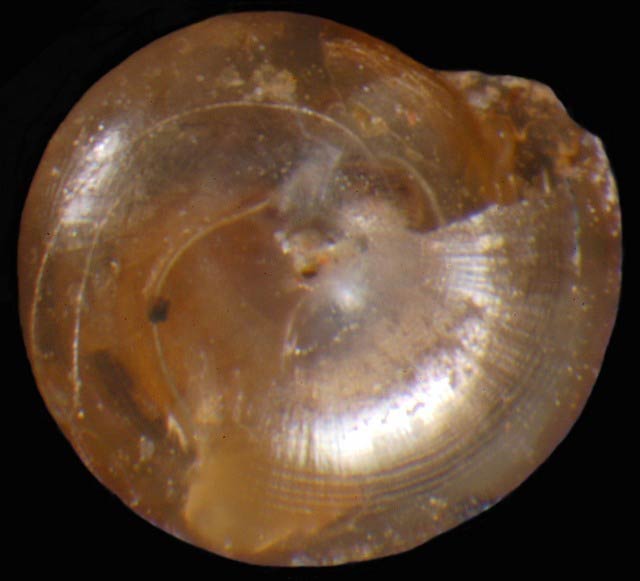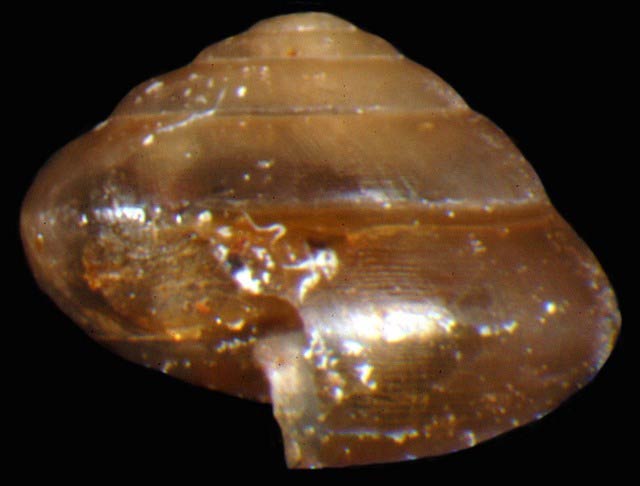Guppya gundlachi
|
Guppya gundlachi. (Photo: © G. Rosenberg, Academy of Natural Sciences) |
|
Guppya gundlachi. (Photo: © G. Rosenberg, Academy of Natural Sciences) |
|
Guppya gundlachi. (Photo: © G. Rosenberg, Academy of Natural Sciences) |
|
Guppya gundlachi. (Photo: © G. Rosenberg, Academy of Natural Sciences) |
Family
Species
Guppya gundlachi (Pfeiffer, 1839)
Common name
Glossy granule
Description
The shellShell:
A hard, inflexible, calcareous or chitinous structure that vary in size and may either completely encasing the animal, covering some part of it or be internal.
of this snail is approximately 1.75 mm in heightHeight:
The height of the shell is a measure of the distance between the apex and the most basal part of the shell OR the measurement taken from the apex of the shell to the base, when measured parallel to the axis of the shell.
and 3 mm in diameter. It has 4 2/3 whorlsWhorls:
Pleural of whorl. A whorl is a complete spiral turn/growth of the shell of a mollusc. The whorls are counted from the apex outwards.
and is generally glossy in appearance. The growth lines on the shellShell:
A hard, inflexible, calcareous or chitinous structure that vary in size and may either completely encasing the animal, covering some part of it or be internal.
are inconspicuous; however, after the smooth apicalApical:
Top side of the shell; opposite of base.
half whorlWhorl:
A complete spiral turn/growth of the shell of a mollusc. The whorls are counted from the apex outwards.
, there are minute, moderately spaced spiralSpiral:
Directional term: direction of the coils of the whorls of a shell; opposite of axial.
lines. The pale brown shellShell:
A hard, inflexible, calcareous or chitinous structure that vary in size and may either completely encasing the animal, covering some part of it or be internal.
of the glossy granule snail is minutely perforated. The depressedDepressed:
Shrunken below a certain level.
shell has a low dome-like appearance from above. The apertureAperture:
The major opening of a shell that the body of the animal may be retracted.
of the shellShell:
A hard, inflexible, calcareous or chitinous structure that vary in size and may either completely encasing the animal, covering some part of it or be internal.
is lunate (half moon-shaped).
Native range
Central America
Distribution
North America:
- U. S.: Florida, Texas
South and Central America
Caribbean: Trinidad, Puerto Rico, Cuba, Jamaica
Asia: Thailand
Ecology
This species is commonly intercepted in shipments of ornamental crops from Thailand to the U.S.
Synonyms
- Helix pusilla Pfeiffer, 1839, Archiv. F. Naturg., 1: 351. Not of Lowe, 1833.
- Helix gundlachi Pfeiffer, 1840, Archiv. F. Naturg., 1: 250; substitute for H. pusilla; 1848, Mon. Hel. Viv., 1: 50.
- Helix simulans C.B. Adams, 1849, Contrib. to Conch., No. 3, p.35 (Jamaica).
- Helix egena Gould inBinney, 1851, Terr. Moll., 2: 245, pl. 22a, fig. 3. Not of Say.
- Guppya gundlachi Pfeiffer, Von Martens, 1892, Biol. Centr.-Amer., Moll., p. 122.; H.B. Baker, 1922, Occas. Pap. Mus. Zool. Univ. Mich., 106: 45, pl. 17, figs. 1,3, jaw and teeth.
- Zonites gundlachi Pfeiffer, W. G. Binney, 1978, Terr. Moll., 5: 127, pl. 22a, fig. 3; pl.2, fig. D, teeth.
- Guppya orosciana
References
Baker 1928; Pilsbry 1946Pilsbry 1946:
Pilsbry, H. A. 1946. Land Mollusca of North America north of Mexico vol. II part 1. Academy of Natural Sciences, Philadelphia. pp. 1-520.; Rosenberg and Muratov 2006Rosenberg and Muratov 2006:
Rosenberg, G. and I.V. Muratov. 2006. Status report on the terrestrial Mollusca of Jamaica. Proceedings of the Academy of Natural Sciences of Philadelphia 155: 117-161.





